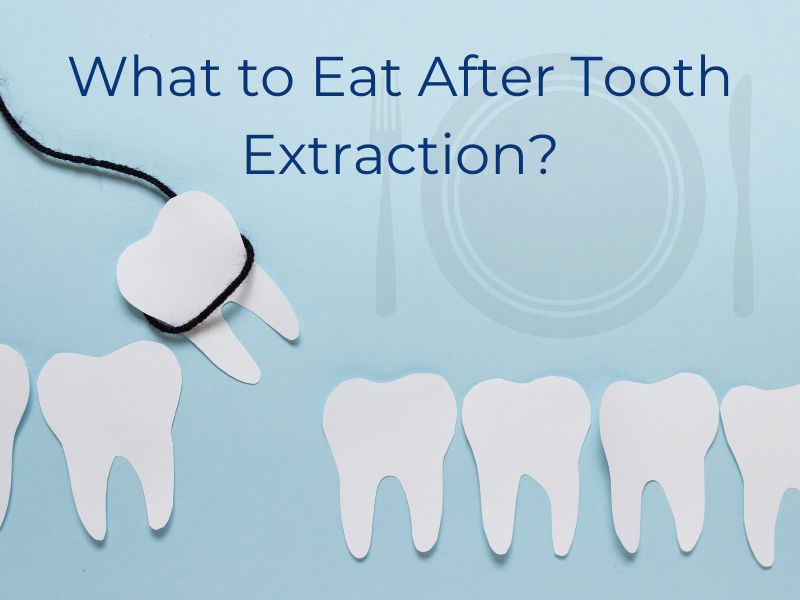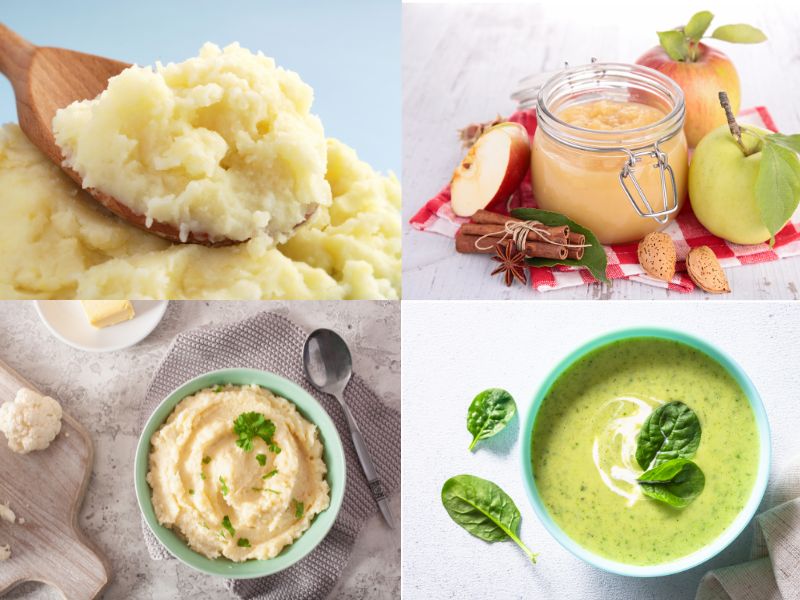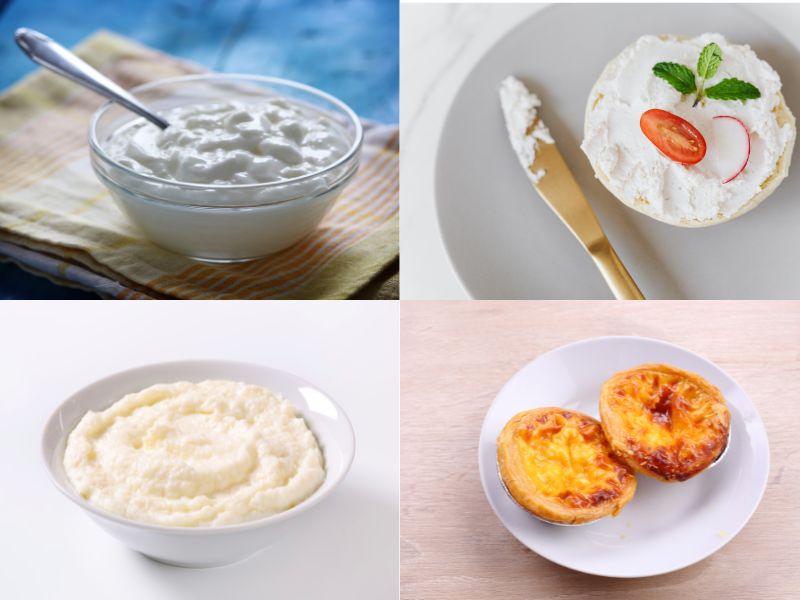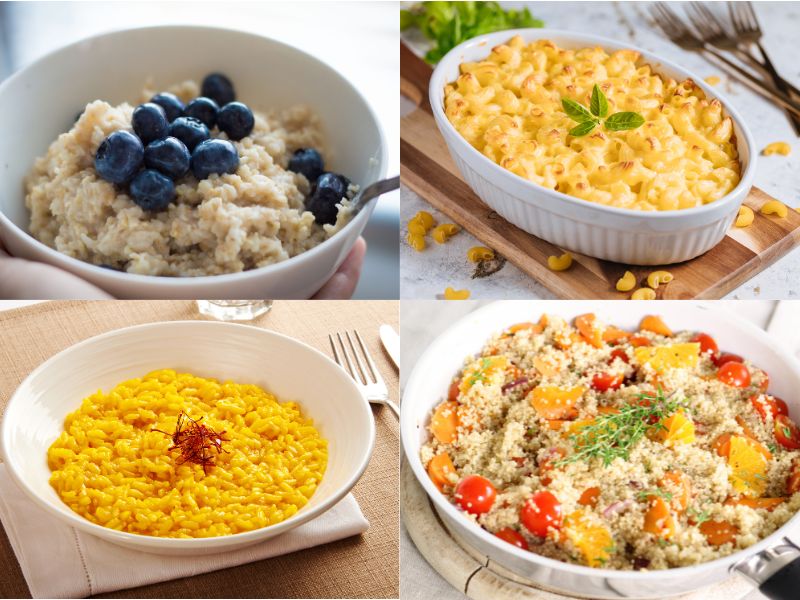60 Soft Foods to Eat After Tooth Extraction
Getting a tooth pulled is no picnic. Your mouth's sore, swollen, and just not in the mood to chew anything hard. But here's the twist! you still need to eat! The right foods will speed up healing, while the wrong foods make things worse. So, what should you do? Consume soft-nourishing, and gentle foods, on your healing gums.

And? Nutrients such as proteins, vitamins, minerals, and essential fatty acids are fundamental in promoting tissue regeneration, reducing inflammation, and enhancing immune responses. Protein, for instance, plays a direct role in collagen synthesis, which is critical for wound closure and structural integrity. Vitamins such as vitamin C and A facilitate antioxidant activity and cellular repair, while zinc accelerates epithelialization and bone formation (Clinic Search).
Pureed and soft foods

Give it a break with easy-to-chew foods that won't mess with your recovery. Now, let's explore the best options to keep you full and healing better. Pureed and soft foods
This category includes easily consumable foods with a soft or pureed texture, perfect for gentle chewing and digestion after a tooth extraction.
- Mashed potatoes
- Applesauce
- Fruit puree
- Pureed beans
- Mashed sweet potatoes
- Mashed cauliflower
- Pumpkin soup
- Cinnamon sweet potato mash
- Pureed chickpea stew
- Creamed spinach
- Blended pea soup
- Blended chicken or turkey soup
- Blended soups
- Soft-cooked lentils
- Mashed pumpkin
Soups and liquid meals
These are nutrient-rich, smooth soups and liquid-based meals, ideal for providing hydration and nourishment while being easy to consume.
- Miso soup with soft tofu
- Crab or shrimp bisque
- Soft-cooked vegetable soup (e.g., carrot, squash)
- Rice congee
- Steamed fish with broth
Dairy and soft desserts

High in protein and calcium, these options help support healing and offer easy-to-chew sweetness.
- Yogurt
- Greek yogurt
- Cottage cheese
- Ricotta cheese with honey
- Soft cheeses
- Rice pudding
- Chia pudding
- Tapioca pudding
- Custard
- Egg custard tart
- Pudding
- Ice cream
- Gelato
- Sorbet
- Milkshakes
Soft proteins
These foods provide essential proteins needed for tissue recovery while being easy to chew and swallow.
- Scrambled eggs
- Poached eggs
- Steamed eggs
- Soft-cooked tofu
- Egg salad
- Blended chicken or turkey soup
- Silken tofu
- Hummus
Carbohydrates and grains

These options offer energy in the form of easily digestible carbohydrates, suited to a soft-food diet.
- Oatmeal
- Cream of wheat
- Porridge
- Soft-cooked pearl couscous
- Macaroni and cheese
- Soft-cooked pasta
- Polenta with cheese
- Quinoa (well-cooked)
- Risotto
- Soft bread soaked in soup or milk
- Gravy
Fruit-based options
These foods are rich in vitamins and minerals, helping to support overall recovery with their soft, easy-to-consume textures. One study showed that vitamin B12 supplementation resulted in lower pain scores at 6 and120 hours post-extraction with no effect on facial swelling. This is a good new for patients.
- Bananas
- Canned fruit (in juice)
- Blended fruit and yogurt popsicles
- Smoothie bowls
- Fruit sorbet
- Fruit smoothie
Foods to Avoid After Tooth Extraction
Several foods after tooth extraction can interfere with healing, cause irritation or cause some complications like dry socket. So, knowing what not to eat is just as important as knowing what you can.
Why are some foods risky?
When your tooth is removed, a blood clot forms over the extraction site. Think of this clot as a natural bandage that protects the sensitive bone and nerves underneath. If it gets dislodged, the site is left vulnerable, which can lead to severe pain and slow recovery. So, you should avoid from some foods.
Foods to Avoid After Teeth Extraction
Hard and crunchy foods
Picture yourself biting into popcorn or a crunchy chip. Harmless, right? Not after an extraction. Those sharp bits can sneak into the wound, disturbing the healing process or even causing an infection. Hard pass on these for now.
Sticky and chewy foods
Caramel, toffee, and gummy candies might sound tempting, but they're like gum for your gums! Too clingy. They can get stuck on the extraction site and dislodge the blood clot that's essential for healing.
Spicy foods
We all love a little spice, but your gums definitely don't. Anything too spicy can irritate the delicate tissue and cause unnecessary pain or inflammation. You'll have plenty of time to enjoy hot wings later. Just not in 1-5 days after extraction.
Acidic foods and drinks
Citrus fruits, tomato sauce, or lemonade might sound refreshing, but to a healing wound, it's like pouring acid on an open cut. These foods can sting and slow down your recovery. Skip the citrus for now.
Alcohol
You might be thinking of a nice glass of wine or others to relax, but alcohol isn't your friend here. It can dry out your mouth and disrupt the healing process. Moreover, if you're on medication, it's a risky combo. Stick to water and soothing teas instead.
Hot foods and drinks
Hot coffee, tea, or soup might seem comforting, but that heat can dissolve the blood clot. No clot, no protection. No protection, dry socket. And this means pain you don't want. Let things cool before you take a sip.
Grains and seeds
Small but mighty annoying! Grains like rice and tiny seeds can easily get trapped in the extraction site. Once they're stuck, good luck getting them out without irritation. Better to go for smooth, seedless options for now.
Tips for Preparing and Serving Soft Foods
Soft foods aren't exactly the most exciting thing on the menu, right? But after a dental procedure or when you're dealing with mouth pain, they're your best friend. You should know how to prepare and serve them so they're both nutritious and easy to eat. Because let's face it! Nobody wants bland mashed potatoes every meal! You can turn a simple bowl of oatmeal into a cozy, flavorful treat with just a few tweaks.
The goal here is to make these foods gentle on your mouth but still enjoyable. And it doesn't mean spending hours in the kitchen either. So, how do you get it right? Let's talk about it under those key headings.
9 Cooking Techniques for Achieving the Desired Soft Texture
1. Puree with care
A blender or food processor is your best friend here. Soups, fruits, and sauces become silky and easy to eat with just a few pulses. But don't overdo it! If it's too thin, it loses that satisfying texture. Think velvety, not watery.
2. Steam for softness and flavor
Steaming is like giving your veggies a gentle spa treatment. It softens them perfectly while keeping nutrients and flavor intact. Plus, steamed carrots or broccoli have a much better texture than anything boiled into oblivion.
3. Boil for fork-tender results
Grains, pasta, and legumes need just the right amount of boiling to get soft. Test with a fork! If it's easy to mash but still holds its form, it's ready. Overcooking? It loses its nutritious value.
4. Mash for creamy comfort
Transform potatoes, sweet potatoes, and even fruits into smooth mash. Add a splash of butter, cream, or milk for that rich, comforting texture. It's all about the balance. Dry mash is not usually good choice.
5. Slow-cook for melt-in-your-mouth dishes
Got tough meats or dense veggies? Slow cooking breaks them down beautifully over time, creating tender, flavorful meals. Think slow-braised beef or soft, hearty vegetable stews. Time is your magic ingredient here.
6. Braise for extra flavor
Braising means cooking meat slowly in a flavorful liquid like broth. The result? Meat so tender it practically falls apart. Perfect for dishes like short ribs or chicken thighs.
7. Keep things moist
Moisture is your best friend when cooking soft foods. Simmering ingredients in broth or soaking bread in milk helps maintain that tender texture. Dry food is hard food. Simple as that.
8. Try gentle baking
Low and slow baking is ideal for casseroles, baked fruit, and soft desserts. The trick is to control the heat so everything softens evenly without drying out. Think of warm, baked apples that melt in your mouth.
9. Choose tender cuts and ingredients
Work smarter, not harder. Softer cuts of meat, like chicken thighs or fish, cook faster and come out tender without much effort. Same goes for ingredients like ripe fruits and soft vegetables.
Portion Control and Frequency of Meals
Recovering from dental work isn't just about sticking to soft foods. How much and how often you eat matters just as much. Imagine stuffing yourself with a huge meal. Your mouth aches, your stomach feels like a brick, and all you want is to crash on the couch. That's not exactly the path to healing?
Eat smaller portions, but more often
Instead of one huge feast, aim for five or six smaller meals throughout the day. Why? It's easier on your mouth and helps keep your energy steady. Healing takes a lot out of you, so regular refueling is a must!
Listen to your body
Still hungry after your meal? Have a small, healthy snack. Feel full halfway through? Stop eating. Your body knows what it needs. Forcing yourself to finish a large portion can make you feel uncomfortable, especially with a sore mouth. It's not a marathon, pace yourself!
Focus on nutrient density
Smaller portions mean you need to pack your meals with nutrients. Think soft proteins like eggs, healthy fats like avocado, and nutrient-rich veggies like spinach. A small, balanced plate can give you everything your body needs to heal faster.
Stay hydrated, but don't fill up on liquids
Drink water but not much during meals. This habit fills you up too quickly. Taking small sips between bites is better.
Avoid mindless eating
Eating while distracted (like in front of a screen) can lead to overeating. Because you don't realize how much you've had, until it's too late! Sit down, focus on your foods, and savor each bite. This eating habit help you eat just the right amount.
Time your meals strategically
Don't wait for eating. It is better to eat every 3-4 hours to maintain steady energy and avoid that post-meal crash.
Keep soft, ready-to-eat options on hand
When hunger strikes, you need something fast. Prep easy snacks like mashed avocado, yogurt, or pre-cooked oatmeal. Having these on hand prevents you from reaching for the wrong foods out of desperation.
12 Hygiene Practices to Prevent Infections During Recovery
1. Rinse gently, but only when it's time
Don't rush to rinse on the first day. Let the blood clot settle like a shield for your wound. After 24 hours, start rinsing with warm salt water, but go easy! No aggressive swishing.
2. Brush carefully
Yes, you still need to brush your teeth, but avoid scrubbing near the extraction site. Use a soft-bristled toothbrush and take gentle strokes. It's like tiptoeing around a sleeping cat! Disturbing it could cause trouble.
3. Avoid poking or prodding the area
Keep your fingers, tongue, and anything else away from the wound. Curious? Don't be. Touching the site can introduce bacteria and disturb the blood clot, making things worse.
4. Skip the straw
Suction from a straw can dislodge the protective clot, leading to dry socket. You don't want that! Just drink straight from a glass for safe.
5. Wash your hands before touching your mouth
Every time you brush or apply ointment, wash your hands thoroughly. You know how quickly bacteria from your hands can reach your mouth and cause infections.
6. Keep utensils and food prep areas clean
When preparing soft foods, use clean cutting boards, utensils, and surfaces. Prevent cross-contamination by separating raw and cooked foods. Treat your kitchen like a lab! Clean and organized keeps bacteria away.
7. Cook foods thoroughly
Make sure meats, eggs, and other high-risk foods are fully cooked. Undercooked food can introduce harmful bacteria, which is the last thing your healing mouth needs.
8. Store leftovers safely
Refrigerate leftovers quickly to prevent bacterial growth. Don't leave food sitting out too long. Hot foods should stay hot, and cold foods should stay cold to minimize risks.
9. Choose nutrient-rich soft foods
Your body needs extra nutrients to heal. These help your body rebuild and recover faster.
10. Stay hydrated
A dry mouth can lead to bacteria buildup. Drink water regularly to keep things moist and flush away debris. Hydration plays a key role in preventing infections.
11. Use antiseptic mouthwash if recommended
If your dentist suggests it, use antiseptic mouthwash to control bacteria. But remember, gentle swishing only. No harsh rinsing!
12. Follow your dentist's instructions
Every procedure is a little different, so always follow the post-op care your dentist provides.
FAQ
How Long After Tooth Extraction Can I Eat Solid Foods?"
You'll need to wait about a week before trying solid foods again. During the first 24 hours, stick to liquids and very soft options like yogurt or mashed potatoes. Your gums need time to heal and form a protective clot.
Can I Drink Coffee After Tooth Extraction?
No, you shouldn't have coffee right away. Hot drinks like coffee can disrupt the blood clot in your wound, increasing the risk of dry socket. Think of it like melting a protective seal too early! It leaves your gums exposed and vulnerable.
You should wait at least 24 to 48 hours. If you really need your coffee fix, stick to room-temperature or iced coffee. Also, caffeine can cause slight dehydration, which may slow healing. Patience is key!
Is Ice Cream Good to Eat After Tooth Extraction?
No, hot coffee can also dissolve the protective blood clot at the tooth extraction site. This clot acts like a natural barrier, preventing infection and protecting nerves. If it's dislodged, you risk dry socket. This is a painful condition you definitely want to avoid. Wait at least 24 to 48 hours. Even then, make sure it is not hot. Think of it like letting a scab form properly.
Can I Use a Straw After Tooth Extraction?
No. Using a straw creates suction that can dislodge the protective blood clot from the extraction site. This exposes the wound and leads to dry socket, causing severe pain and delayed healing.
Avoid straws for at least a week. Drink directly from a glass to keep the clot intact. Let your mouth heal naturally. It's the best way to avoid complications.
When Can I Resume Normal Eating Habits After Tooth Extraction?
You can typically return to normal eating after about 7 days. You can follow plan below:
Day 1: Stick to liquids and very soft foods like mashed potatoes or yogurt. Avoid hot, crunchy, or chewy foods.
Days 2-5: Gradually introduce soft, easy-to-chew foods like scrambled eggs, pasta, or oatmeal. Avoid anything hard, spicy, or sticky.
Day 7: If healing is going well, you can start eating tender solids like fish or chicken. Still avoid extreme textures (very hard or chewy).
Listen to your body. If it feels uncomfortable, take more time before adding tougher foods. Follow your dentist's advice for the best recovery.
Is caffeine OK after a tooth extraction?
No, not generally within the first couple of days. Caffeine can increase blood flow and blood pressure, which may put you at a higher risk of bleeding in that initial surgical recovery period. We recommend giving it a miss for a few days, around five.
